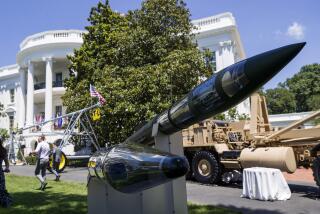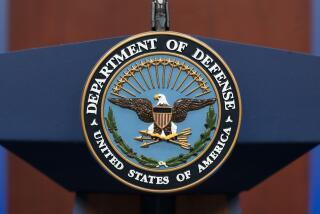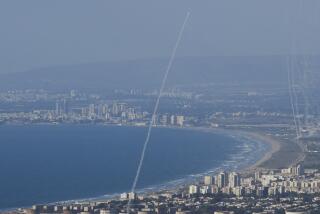CRISIS IN THE PERSIAN GULF : U.S. Armored Units Arrive to Anchor Ground Forces : Military: The meager tank force in desert is bolstered. Shipments bring the deployment to promised levels.
DHAHRAN, Saudi Arabia — The massive U.S. buildup in the Persian Gulf, more than two months in the making, entered its final stage Sunday as M-1 tanks from two of the Army’s most potent units rumbled ashore in preparation for possible combat against Iraq.
The armored arrivals, from the Army’s 1st Cavalry Division and 3rd Armored Cavalry Brigade, effectively double the size of a previously meager American tank force, making them a centerpiece of the U.S. military power dispatched to Saudi Arabia.
These new shipments bring to more than 200,000 the number of U.S. troops in the region in a force that now includes 1,000 tanks, nearly 500 combat aircraft and 59 Navy warships.
With some exceptions, this is essentially the level of force that U.S. officials have been promising to put in place in Saudi Arabia since President Bush announced the military initiative in the Middle East more than two months ago.
“This is it,” a senior military official declared. “If it comes to battle, this is what we’ll have to fight with.”
Nevertheless, Defense Secretary Dick Cheney on Sunday left open the possibility that additional troops and equipment might be sent here in the future if the U.S. commander, Gen. H. Norman Schwarzkopf, and others decide it is necessary.
“We’ve now surpassed the 200,000 mark within the last few days, and the deployment is not yet complete,” Cheney told reporters en route from Washington to London, where he will meet with top British defense officials. “That is, Gen. Schwarzkopf has not come back and said: ‘OK, I’ve got what I need.’ So the buildup will continue for a while longer.”
Military officials here cautioned that even with the new tank reinforcements, American armored power would not be able to carry out a successful frontal assault on dug-in Iraqi defenders, who have an estimated 430,000 troops and 3,500 tanks along the frontier of Kuwait and Iraq with Saudi Arabia.
But with the armored force here now at projected full strength, the commanders stressed that the United States for the first time will have the capability of pinning down Iraqi ground forces in coordination with any U.S. strike against Iraq by air and sea.
Some military officials have said that because the logistics network is still not entirely complete, American forces may not be ready for combat for at least another month. But one ranking official, who declined to be identified, said those estimates are too cautious.
“They are never going to specifically say, ‘We’re ready,’ ” he noted. “There’s always going to be something more they would like to have.”
In their deployment from Ft. Hood and Ft. Bliss in Texas, the last two Army tank units to arrive in Saudi Arabia were slowed by a shortage of U.S. fast-sealift ships and by breakdowns that put their arrival about a week behind schedule, officials said. Four U.S. ships involved in Operation Desert Shield remain under repair in foreign ports.
The two additional armored units began to trickle into Saudi Arabia last week. Their M-1 tanks rolled off the fast-sealift ship Bellatrix on Sunday morning, and by midweek they should have all of their tanks as well as their Bradley fighting vehicles and Apache attack helicopters.
The newly arriving units, which include a brigade of the 2nd Armored Division, contain a force of more than 15,000 soldiers and already have begun to shore up what had been a very thin line in the sand established by American ground forces.
The armored units will move quickly to forward positions, where U.S. forces have been spread thin. To the fewer than 200 Army M-1 tanks previously in the country, the new units will add about 400 more M-1s, the Army’s heaviest tank.
Only a small number of the tanks, however, are M-1A1s, whose 120-millimeter guns make them clearly superior to Iraq’s force of 500 Soviet-made T-72s. While the 1st Cavalry would normally use M-1A1s, those tanks remain positioned in Germany, leaving the 1st to rely on what are essentially second-string tanks with 105-millimeter guns.
There are also more than 200 Marine Corps medium-weight M-60 tanks in Saudi Arabia, with a smaller force of M-60s deployed offshore as part of a Marine amphibious force. The Marine force is to be joined by the end of this month by a British armored combat brigade with 120 tanks.
Even though Cheney left open the possibility of deploying additional men and weapons, authoritative sources in Washington and Saudi Arabia said that there has been almost no discussion among top military commanders in recent weeks of converting this defensive force into an offensive force to be used against Iraq.
A senior Army official said that the daily Pentagon briefings on the military situation in Saudi Arabia continue to stress the defensive nature of the U.S.-led force. “There is no indication of any offensive options, not even any under discussion,” he said.
In Saudi Arabia, an air commander added in an interview: “We’re a lot further from that than most people think.”
“Our position is that we’ve deployed our forces in the region to deter, defend and to enforce the sanctions,” Cheney said. “That’s the instructions I’ve got. I have not been given other instructions.”
Although the American armor has never been viewed as a ground-taking force, the newly bolstered tank units are seen as a formidable blocking power in coordination with an air attack. As part of overall strategy, a senior Marine Corps officer in Washington said, U.S. armor could “put pressure on the Iraqi lines” sufficient to pin the enemy down.
“We’ll give (Iraqi President Saddam Hussein) an opportunity to surrender and if he doesn’t, then we can try to exploit his weaknesses,” the officer added.
For now, however, the arrival of the armored units will enable the United States to sharply intensify the pace of ground operations in Saudi Arabia, including extensive combat exercises that could send a message to Hussein.
Among the planned operations, officials said, are the first joint U.S.-Saudi exercises since Operation Desert Shield began, along with the first coordinated exercises by U.S. Army and Marine forces that have been deployed in adjoining sectors here for nearly two months.
The principal purpose of such exercises would be to sharpen troops’ fighting skills after weeks of often tedious desert duty, officials said. A secondary goal, they indicated, is to send Iraq a signal about increasing U.S. combat readiness.
Such exercises may include front-line forces, made up mostly of Saudi Arabia’s 65,000-man army, bolstered by forces from Syria, Egypt and countries of the Gulf Cooperation Council. French forces also have deployed to some forward areas.
Times staff writer John M. Broder in London contributed to this report.
More to Read
Sign up for Essential California
The most important California stories and recommendations in your inbox every morning.
You may occasionally receive promotional content from the Los Angeles Times.










